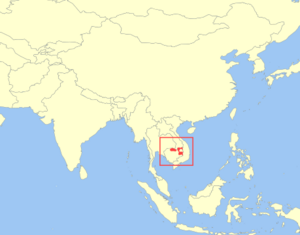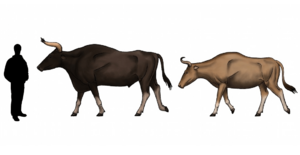Kouprey facts for kids
Quick facts for kids KoupreyTemporal range: Middle Pleistocene–Holocene
|
|
|---|---|
 |
|
| The holotype specimen, a young bull at the Paris Zoological Park, 1937 | |
| Conservation status | |
| Scientific classification | |
 |
|
| Geographic range | |
| Synonyms | |
|
Bos (Bibos) sauveli (Urbain, 1937) |
The kouprey (Bos sauveli), also known as the forest ox or grey ox, is a type of wild cattle. It lives in forests in Southeast Asia. Scientists first described it in 1937.
The name "kouprey" comes from the Khmer language. It means "forest ox." This animal is listed as Critically Endangered and might even be extinct. The last time someone definitely saw a kouprey in the wild was in 1969.
Contents
Discovering the Kouprey
The kouprey was first described by a scientist named Achille Urbain in 1937. He studied an adult kouprey that was caught in northern Cambodia. This animal was then kept at the Paris Zoological Park.
Scientists have studied the kouprey's mitochondrial DNA. This is like a genetic fingerprint. In 2006, some thought the kouprey might be a mix of zebu and banteng. However, later studies showed that the kouprey is its own unique species. It is closely related to the banteng and gaur.
Relationships of members of the genus Bos based on nuclear genomes after Sinding, et al. 2021.
| Bos |
|
|||||||||||||||||||||||||||||||||
What Does a Kouprey Look Like?
The kouprey is a light and graceful animal. It is not as heavy as other wild cattle. Both male and female koupreys have notched nostrils. An adult kouprey is about 7 to 7.3 feet (2.1 to 2.2 meters) long. It stands about 5.6 to 6.3 feet (1.7 to 1.9 meters) tall at the shoulders. It can weigh between 700 and 900 kg (1,500 to 2,000 pounds).
Young kouprey calves are reddish-brown. They turn grey when they are about five months old. Their horns start to grow when they are six months old. As they get older, male and female koupreys change color. Females become mouse-grey to brownish-grey. Males get darker and darker. By 12 years old, old males are completely dark brown. Both sexes have white "stockings" on their legs. They also have a dark stripe down the front of each front leg.
Horns and Dewlaps
Male and female koupreys look different, especially their horns. This is called Sexual dimorphism. Male koupreys have wide-set horns. These horns grow outwards, then curve forwards and upwards. Their tips often look frayed. Female koupreys have horns that spiral upwards, looking like a lyre. Male horns can be up to 32 inches (81 cm) long. Female horns are shorter, up to 16 inches (41 cm).
Older male koupreys grow a large flap of skin under their neck. This is called a dewlap. It can be as long as 16 inches (40 cm). Sometimes, the dewlap is so big that it drags on the ground.
Where Koupreys Live
The kouprey used to live in many parts of Southeast Asia. Its home stretched from southeastern Thailand and southern Laos. It also lived in western Vietnam and northern Cambodia. Old findings show they were also in northern Yunnan, China.
Koupreys prefer a mix of open grasslands and forests. These forests have scattered trees, grassy clearings, waterholes, and places with salt.
Kouprey Behavior and Life Cycle
Koupreys act much like bantengs, another type of wild cattle. They often graze together, but they do not mix their herds. Kouprey herds are led by an older female. These herds usually include females, their young, and sometimes males. Koupreys are active but also very nervous. They run away quickly if someone gets too close. Male koupreys have been seen digging up soil with their horns. They do this especially around mineral licks and waterholes. This is why their horn tips often look frayed.
To avoid the heat, koupreys eat in the early morning and late afternoon. During the middle of the day, they move into thicker forests to rest. We do not know much about what they eat. However, they are known to eat different grasses and some leaves. They also eat mineral-rich soil.
Reproduction and Lifespan
Koupreys mate in April. The males then go back to their own groups by early May. Pregnancy lasts between 8 and 9 months. Females give birth to one calf between December and February. A female kouprey will leave her herd to give birth. She stays away with her calf for about a month after it is born. Koupreys are thought to live for about 20 years.
Why Koupreys Are in Danger
Koupreys have probably never been very common. In the 20th century, there were likely fewer than 2,000 of them. By 1989, it was thought there were fewer than 200 in Cambodia. Laos had between 40 and 100, and Vietnam had fewer than 30. As of 2016, experts believe there are no more than 50 koupreys left in the wild. Their numbers are still going down.
Local people have hunted koupreys for their meat, horns, and skulls. The skulls are very important in their culture.
Other Threats
Hunting for trophies has also put pressure on koupreys. This started when Westerners discovered them in the 1930s. Wars and conflicts, like the Cambodian Civil War, have also hurt the species. They destroyed kouprey homes and led to more poaching. These conflicts also stopped efforts to protect the animals and study them.
Snares are a big danger for any koupreys that might still be alive. Snares are traps that catch animals by their legs. A 2020 report estimated that over 12.2 million snares were in protected areas in Cambodia, Laos, and Vietnam.
Protecting the Kouprey
Efforts to save the kouprey started in 1960. Norodom Sihanouk, who was the leader of Cambodia, made the kouprey a protected species. He also created three special areas to protect them. These areas were kept up by his successor, Lon Nol. However, during the rule of the Khmer Rouge under Pol Pot, these efforts stopped. Many forestry staff were killed, and all documents about the reserves were destroyed.
Even though some expeditions tried to find koupreys in the 1950s, real conservation work did not start again until the 1980s. In January 1988, a big meeting was held in Hanoi, Vietnam. It was called the "International Workshop on the Kouprey: Conservation Programme." This meeting aimed to create a plan to save the kouprey. Many groups worked together, including the IUCN and the governments of Cambodia, Laos, Vietnam, and Thailand.
In 2011, the IUCN looked at photos from camera traps in northern Cambodia. Even in places where koupreys were known to live, they found no evidence of the animal. In late 2022, researchers started a new study. They are looking at old surveys and camera trap records. Their goal is to find out if there are still suitable places for koupreys that have not been searched yet.
Koupreys in Zoos
Only two koupreys have ever been kept in zoos. A young male was caught in Preah Vihear Province, Cambodia. It was sent to the Paris Zoological Park in April 1937. It lived there with a young gaur and a young water buffalo. This kouprey died during World War II. Another calf was kept by Norodom Sihanouk in the 1950s, but we do not have many details about it.
Kouprey in Culture

There might be pictures of koupreys in ancient rock art in Cambodia's Cardamom Mountains. Carvings at the temples of Angkor Wat also look like the animal.
The kouprey is the national animal of Cambodia. Norodom Sihanouk gave it this title in 1960. The country's national football team is also nicknamed "the kouprey."
Many statues of koupreys have been built across Cambodia. You can find them even in the capital city, Phnom Penh.
In 2022, a model wore a costume showing a kouprey during the Miss Grand Cambodia contest. This caused some debate among viewers. Many felt the costume did not show enough respect for the animal.



